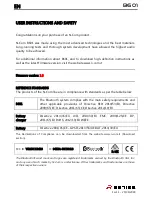
Wireless CHiMe BUliK Drs-982
Main features:
• Perfect as a doorchime, a restaurant / hotel “reception” bell, an internal recall device
• The doorbell installation is not needed
• Chime connected directly to 230V AC socket outlet
• Useful at home, a restaurant, a hotel, a company office, and for special care people
• Radio transmission (433.92 MHz operating frequency)
• Possibility of setting the user’s individual code (16 codes to select)
• Possibility of interoperation with the following wireless push-buttons simultaneously: PDH-991 (hermetic, 150 m* operating range),
PDH-227 (hermetic, 100 m* operating range) and PDB-233 (the reception bell, 100 m* operating range)
• It is possible to increase the number of the bells and push-buttons, if needed
• Possibility of increasing the operating range by means of RT-236 retransmitter of ZAMEL (by another 100 m*)
• Two sounds to select (a possibility of identification of the push-button pushed)
• Loudness volume control
• Optical signalling (LED) of the bell signal receiving
• Chime sound: DING - DING or DING - DONG, DING - DONG
• Sound level: approx. 85 dB
i. TeCHNiCAl DATA
Sound level: approx. 85 dB
Coding: 16 channels
Power supply: 230V AC / 50 Hz
Stand by power consumption: 1.8 VA
Maximum power consumption: 2.8 VA
Transmission: radio
Operating frequency: 433.92 MHz
Protection class: II
IP protection: IP 20
Chime sound: DING-DING or DING-DONG, DING-DONG
Temperature operating range: 0°C ÷ 35°C
ii. AVAilABle BUliK CHiMe VersioNs (Fig.1):
DRS-982 (with no push-buttons)
PDH-227 (a hermetic push-button, 100 m* operating range)
PDH-991 (a hermetic push-button, 150 m* operating range)
PDB-233 (a hermetic push-button, 100 m* operating range)
DRS-982 K (DRS-982 + PDH-227 hermetic push button)
DRS-982 H (DRS-982 + PDH-991 hermetic push button)
RT-236 (retransmitter, 100 m* operating range)
*The given range concerns opened area i e perfect conditions, without obstacles. If between the transmitter and the receiver obstacles are found, then it
can be expected smaller range for: wood and plaster from 5 to 20%, the brick from 20 to 40%, armed concrete from 40 up to 80%. By metallic obstacles
applying radio systems isn’t being recommended from the attention for considerable limiting the radius. Also overhead and underground power lines have
the negative influence on the range of big power and transmitters of the GSM network put in the walking distance of devices
iii. iNsTrUCTioN MANUAl
a) How to launch the chime
1. Check if there is a complete set in a package (the chime, impaired seal with an overprint on the chime back wall).
2. Check if voltage in your socket outlet is 230VAC.
3. Insert the chime into 230VAC socket outlet (Fig. 2).
4. Check if the yellow LED in the bell casing lights.
b) The sound level adjustment
1. Remove, levering it with the use of a screwdriver, the cover placed on the bell front side horizontally. There are the code switches
and the sound level adjustment handwheel under the cover (Fig. 3, 4).
2. Adjust the sound level to your needs with the handwheel.
3. Place the chime switches cover.
c) Code changing
1. All the chimes have the same factory set code. In order to avoid automatic chime start (e.g. by your neighbour) it is recommended
to set the user’s individual code.
2. Remove the chime from the socket outlet (Fig. 2).
3. Remove, levering it with the use of a screwdriver, the cover placed on the bell front side horizontally. There are the code switches
and the sound level adjustment handwheel under the cover (Fig. 3).
4. With the use of switches 1, 2, 3, 4 inside the bell and the push-button set the same code selected by yourself (Fig. 4, 5a, 5b, 5c).
5. Place the chime switches and the push-button cover.
6. Insert the chime into the socket outlet.
7. Check the chime operation by means of pushing the push-button.
d) sound type setting
It is possible to set BULIK chime sound type only with the use of the push-buttons interoperating with the chime. These push-buttons
are: PDH-227, PDH-991, PDB-233. You can change the sound type with the use of switches 5 and 6 in each push-button (Fig. 6a, 6b,
6c). Please, remember that the switches positions in the push-buttons should be different. If not, the bell will not operate.
NoTe!
1. The wireless chime is ready to use after approx. 10 seconds after inserting into the socket outlet.
2. The wireless chime is being operated with the use of radio waves. Therefore, if there are obstacles on the signal way (walls, metal
/ concrete structures), the device operating range may decrease significantly.
3. It is recommended to avoid mounting the push-button directly on a metal substrate.
4. If the chime operating range is insufficient, you may increase the range by 100 m* with the use of RT-236 retransmitter of ZAMEL.
It is recommended to use the retransmitter in high volume rooms and complex shape objects. If needed, it is possible to increase
the number of retransmitters in order to cover the whole object area of any dimensions.
5. If any automatic chime starts occur, it means that there is another chime system in the neighbourhood running in the same
channel. It is necessary to change the device code.
6. All the chimes have the same factory set code.
The Declaration of Conformity is on our Website www.zamelcet.com
gB
ZAMEL devices marked
with this sign can work
with each other
Summary of Contents for DRS-982
Page 20: ...AR ...




































